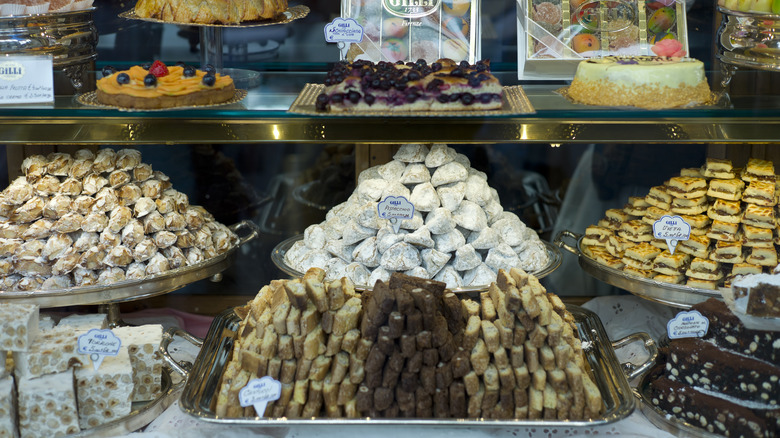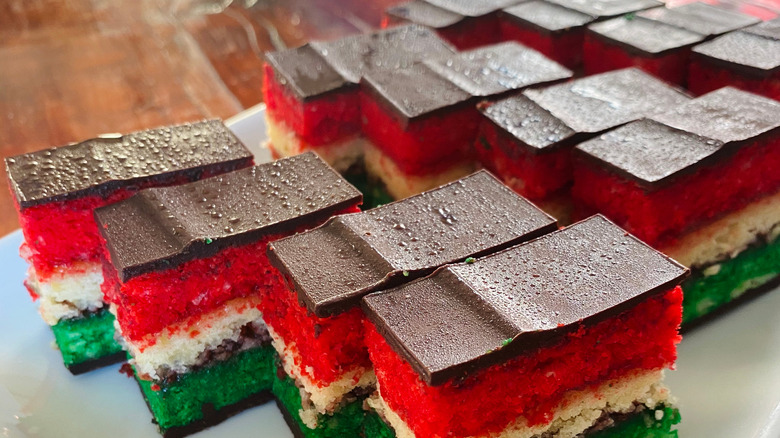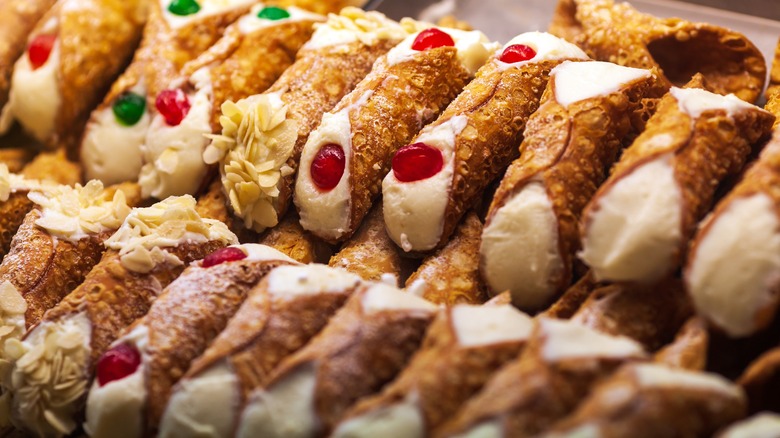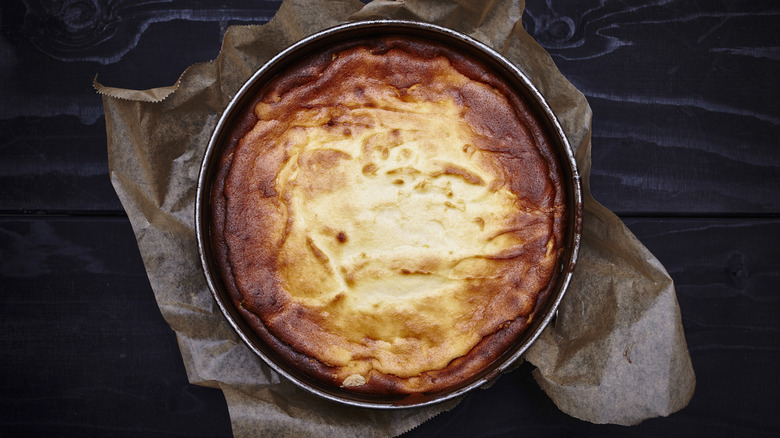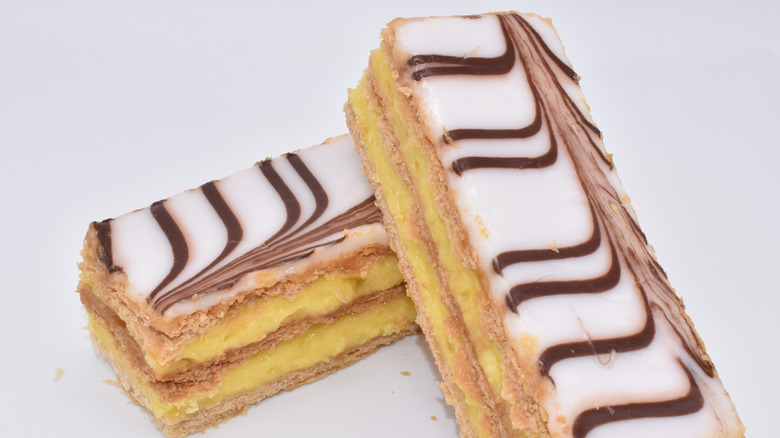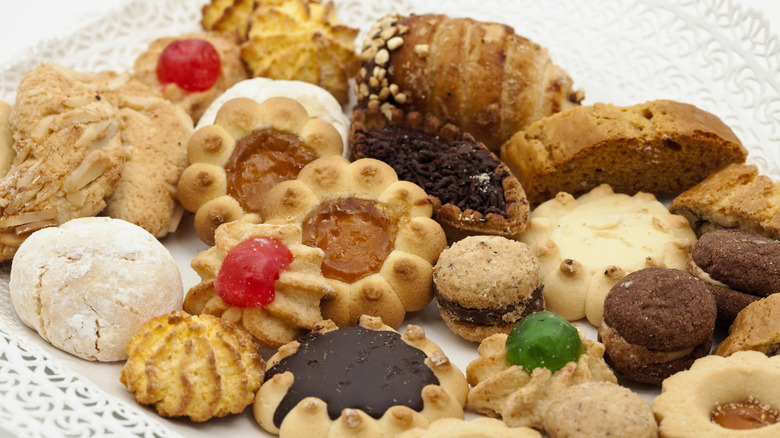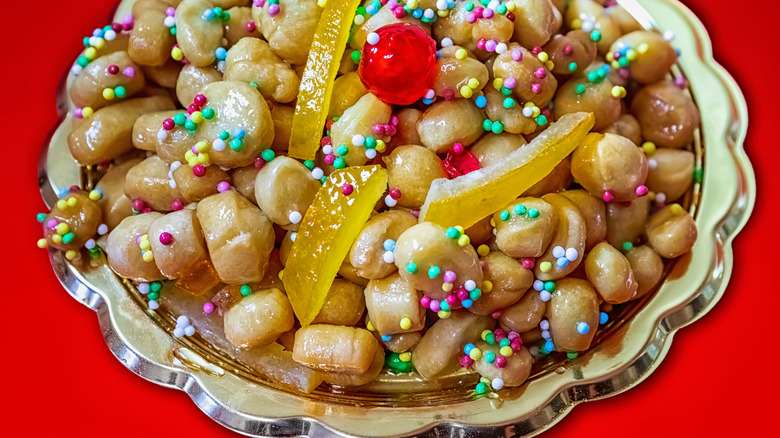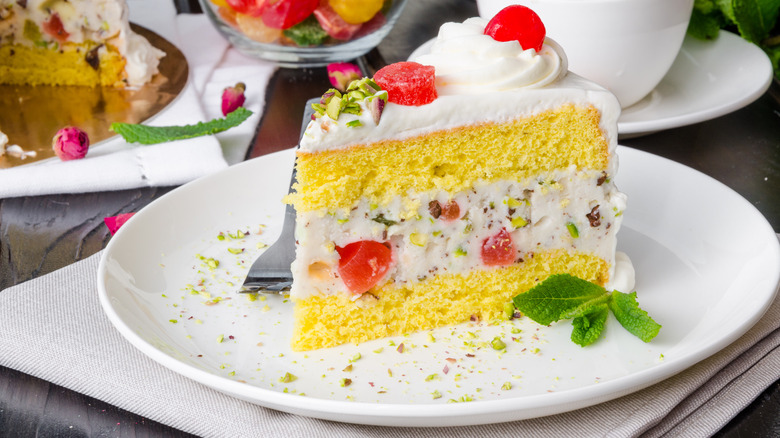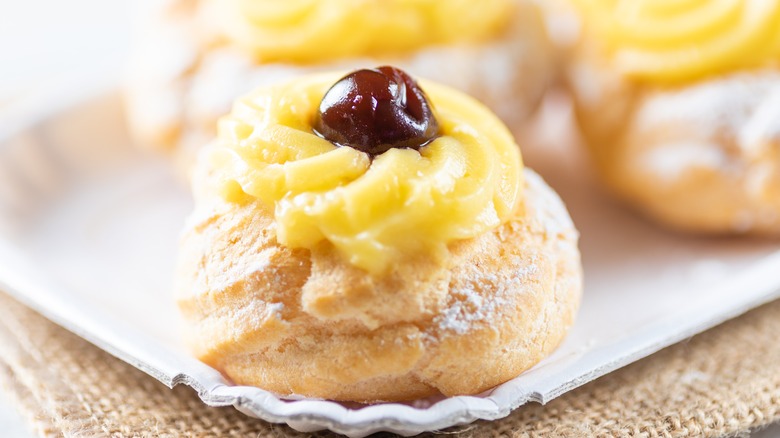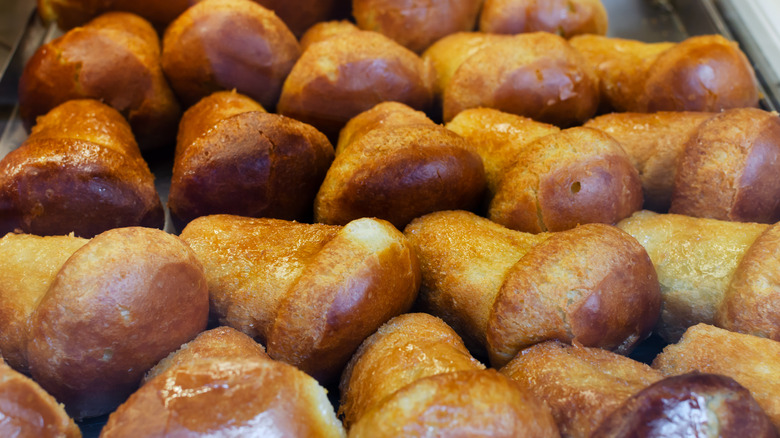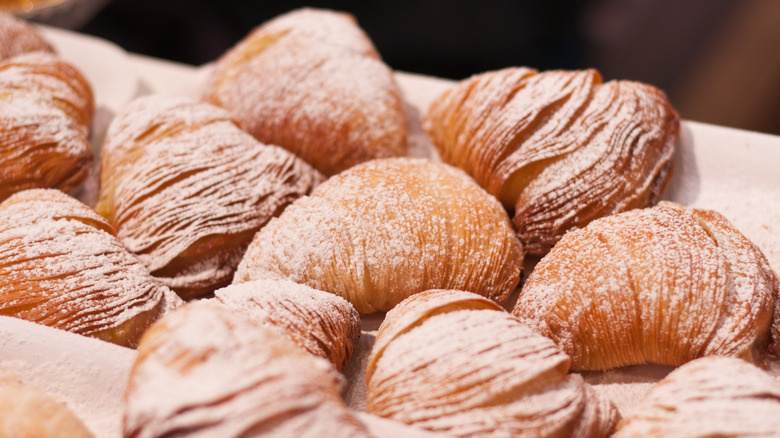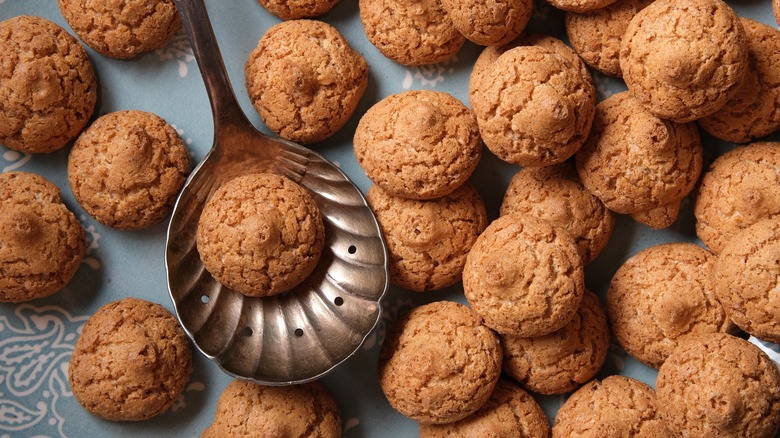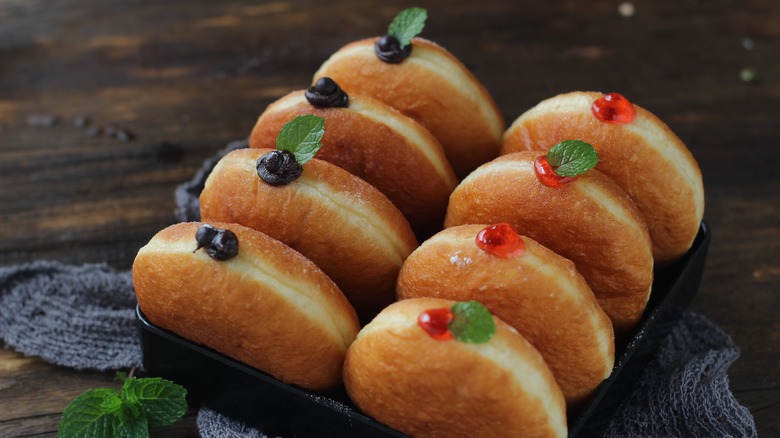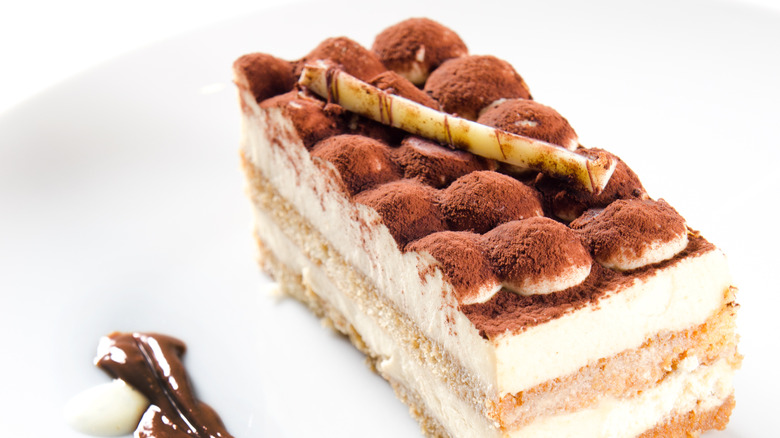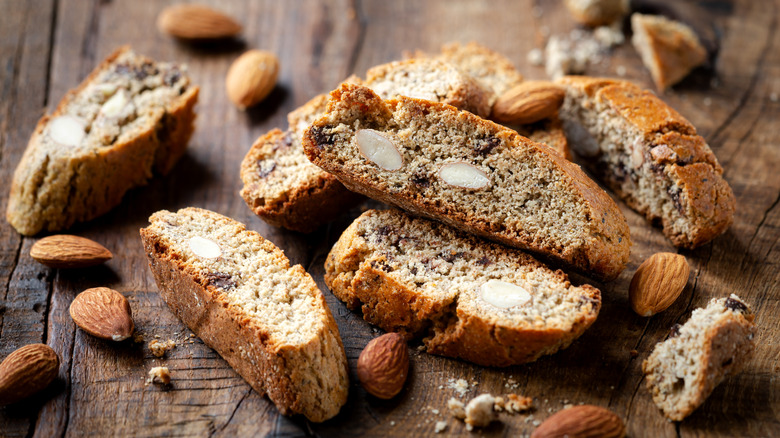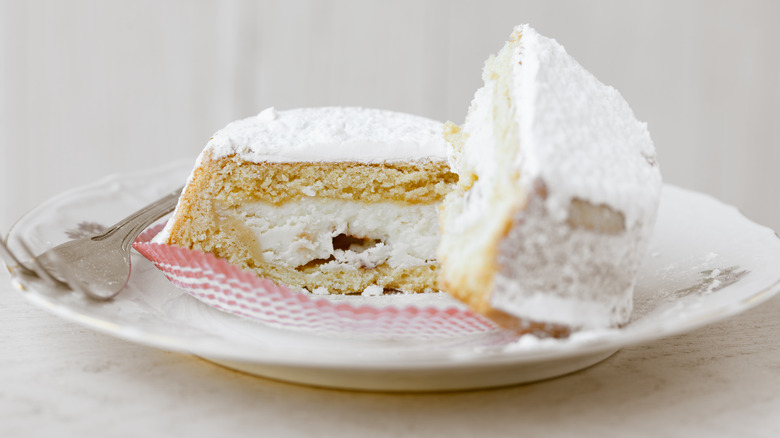15 Items You'll Commonly Find At An Old School NYC Italian Bakery
The Italian bakery has remained a mainstay among New York institutions since the arrival of Italian immigrants in the early 20th century. They brought with them the best of mostly southern Italian and Sicilian pastries, cakes, and cookies. These delicacies all share a mixed past, some equally as French as they are Italian, and others showing Arabic-Sicilian influence. Many of the items continue to be made in the Italian tradition, while others morphed into something uniquely Italian-American.
These baked goods were found at many old-time bakeries throughout NYC's five boroughs. Italian cookies used to be a staple at the long-gone Walken's Bakery in Astoria, Queens. Cannoli and rainbow cookies are still going strong at bakeries on Arthur Avenue in the Bronx, called New York's "real Little Italy." Whether in the boroughs or midtown Manhattan, Italian bakeries offer treats containing the old-world spirit of New York City in every bite. One thing's for sure — New Yorkers know the difference between "Italian" bakeries tourists frequent for black-and-white cookies and the real thing. Here you can discover all the best Italian bakery goods, from holiday favorites to those you crave all year long.
Rainbow cookies
The Christmas season in New York City means rainbow cookies are in high demand at the bakery. The red, green, and white layers perfectly mirror our childlike excitement for the holidays. Few other bakery items are as colorful as rainbow cookies, also called tricolor or Neopolitan cookies. Italian rainbow cookies break the rules from the start since they're not a cookie at all, but almond sponge cake. They're made in the same way many Italian sponge cakes are crafted using rum and almond paste. The layers are held together with apricot or raspberry jam filling.
They then became Americanized when covered with chocolate and used to celebrate the colors of the Italian flag. Rainbow cookies also sometimes show up in Jewish and Greek bakeries, since they belong to all of New York City. The bright colors and soft almond cake flavor of a rainbow cookie give the black-and-white cookie a real run for its money.
Cannoli
Cannoli are the classic New York Italian pastry people endure long travel times and lost luggage to say they've tried. New Yorkers and tourists alike can recall the famous line from "The Godfather," "Leave the gun, take the cannoli." Cannoli consists of a fried tube-shaped pastry shell filled with sweet ricotta cheese. In addition to candied fruit or chocolate chips, cannolis are often dipped in nuts including almonds or pistachios. Sometimes, the cannoli shell is dipped into chocolate to make them officially American.
They're an Italian delicacy but are actually Sicilian, dating back to Arab rule during the 10th century. The story goes, Sicilian cannoli were created by a harem of women to honor the prince's "manhood" with its shape. They were also called "Cappeli de Turchi," meaning "Turkish hats." Cannoli has traveled a long way to become probably the most recognizable item in any self-respecting Italian bakery that calls New York home.
Italian cheesecake
You can't talk about New York City without mentioning cheesecake. Even American-style cheesecake made with cream cheese is called New York cheesecake. Once you leave the touristy spots and find yourself an authentic Italian bakery, you will discover the delicate beauty of Italian cheesecake. Instead of cream cheese, the same ricotta cheese appearing inside cannoli is used, sometimes along with mascarpone. Ricotta and mascarpone are responsible for the airy creaminess of an Italian cheesecake that's less cloying than its American counterpart.
The base is either made from an Italian biscuit cookie instead of a graham cracker crust or is absent. Sicilian cheesecake sometimes but not always appears with a "baked" crust on the top of the cake. It is adorned with the same toppings as New York cheesecake, like berries or chocolate drizzle. Some very Italian variations in flavor give us the super popular lemon and almond cheesecake.
Napoleon
Napoleons are the delectable stacked pastries brimming with pastry cream and flaky crust we all recognize from their scalloped chocolate design on top. Napoleons are less known than cannoli primarily because of their confusing history. They're considered a French pastry and the cornerstone of any French patisserie. Some say the Napoleon was invented in 18th-century France when Napoleon himself ate a cream puff before the Battle of Waterloo. They're technically a type of mille-feuille, meaning "1,000 layers (or leaves)" because of the layers of puff pastry.
There's another theory that they're really Italian and were named for "Neapolitan," referring to someone from Naples. The big difference between Napoleons found in Italian bakeries instead of the French Napoleons is the use of almond paste in the pastry cream. Almond is one of the most revered Italian flavors for baking and a Napoleon is one of the best representations of the flavor.
Italian butter cookies
If you grew up in or around New York City, there was an unspoken rule never to show up at a gathering without a box of Italian butter cookies in tow. For those who don't know Italian butter cookies, you probably actually do. Italians like to keep recipes simple. This couldn't be more true than it is for rich and crispy Italian butter cookies. With more than one shape, some are sandwiched with raspberry jam and others are half-dipped in chocolate and sprinkles (another American favorite).
The Italian biscuit or cookie is said to have been invented by Antonio Mattei in the mid-1850s around Florence. Why these particular Italian cookies come in a variety, but all taste similar is a question for the ages. Perhaps you'll find the answer the next time you're picking through a 1-pound box of buttery cookies. You'll be safe in the knowledge that each cookie, regardless of its appearance, tastes nothing short of delicious.
Struffoli
Many New York bakery goers like to fancy themselves an expert after they've sampled more than a few cannolis. Maybe they're gone through many red and white-tied boxes of butter cookies. But, the day they spot a pyramid-shaped dome sitting on top of the bakery shelf is a day most won't forget. It must be the Christmas season, and they must be looking at homemade struffoli. Also called pignolata in Calabria, and cicerchiata in Abruzzi, struffoli are tiny fried dough balls rolled in honey and topped with candied fruit and sprinkles.
Like many New York food traditions, they came from Naples but originated in Greece. The word "struffoli" comes from the Greek "stróngylos," meaning "round." They're as sweet as little donut holes and are memorable because of the honey flavor. Struffoli ends up as the festive Italian treat that kids can't wait to take apart one by one during the holidays.
Cassata cake
Cassata cake is (almost literally) the crown jewel on any Italian bakery shelf in New York City. You can't miss the bright green color that's a constant in any authentic cassata cake, which comes from marzipan. Many confuse the cassata cake found in New York bakeries with another Italian tradition, the rum layer cake. A cassata cake uses ricotta cream between the layers along with candied fruit throughout the cake.
Cassata cake was invented in the 10th century in Sicily while under Muslim rule. The word "cassata" is linked to the Arabic "qas'ah," which refers to the bowl used to shape the cake. The real beauty of a cassata cake comes with the decoration. Jewels of candied fruit like cherry, orange, and lemon are arranged on top of the green marzipan. The cake ends up as stunning as a stained glass window, or one found in an Arabic royal household of yesteryear.
Zeppole di San Giuseppe
Every time a set of New York City streets are blocked off on a sunny Saturday afternoon, you're bound to see zeppole. It's the Italian version of fried dough, the same appearing in sweets from Mexican churros to Nigerian puff puffs. Zeppole di San Giuseppe is the ultimate expression of this festival-happy street food. Instead of a fried fritter sprinkled with sugar (fine on its own we'd all agree), these zeppole come with pastry cream either inside or on top. Like many Italian bakery staples, zeppole di San Giuseppe is finished with a glacé cherry.
The whole point of these extra-special zeppole is St. Joseph's Day on March 19. It also happens to be Father's Day in Italy, which is when they pop up all over the place. In September, you might even find some Zeppole di San Giuseppe at the Feast of San Gennaro in Little Italy. Why? Just because they're so good you can't wait until March.
Rum babà
Like other Italian bakery specialties, rum babà (or babà al rum) falls under the category of "Is it Italian or is it French?" Their beginnings are contentious, to say the least. The rum babà stems from 1835 with Maria Leszczyńska who married Louis XV of France. Her Polish pastry chef named Nicolas Stohrer first created rum babà using the then-trendy Jamaican rum. Others date rum babà to 1836 and the first culinary cookbook written by Vincenzo Agnoletti for Napoleon's second wife, Marie Louise.
It's hard to figure out whether these pastries were first enjoyed in Italy or France. We may never truly know who invented rum babà first but thank goodness they did. The day someone realized how satisfying it would be to bite into a rum-soaked cake topped with more rum syrup was a good one indeed. When in the mood for the perfect sweet bite post-Manhattan shopping spree, rum babà will satisfy anyone's craving.
Sfogliatella
You do not have to be afraid to order sfogliatella when you next visit a New York Italian bakery. If you are a character on "The Sopranos," you might say "SVOO-ya-Dell." You can also call it a lobster tail, which many Americans do. However you call it, sfogliatella is a ricotta-filled Italian pastry you have to try that boasts flakey layers of buttery dough. It has so many layers (when made properly) that it's likened to a seashell.
Sfogliatella originated in the Santa Rosa convent on the Amalfi Coast of Italy. A well-seeming nun accidentally mixed semolina flour and ricotta cheese together into the shape of a monk's hood. The filling can vary but is likely to use those age-old Italian favorites of almond and citrus for flavor. Sfogliatella is a stand-out choice when visiting your favorite New York bakery for a sweet start to the day in the city.
Amaretti cookies
Amaretti cookies are a wonderful first step into the world of Italian baked goods. They're especially ideal for those who don't want to get weighed down by rich cakes or heavy cream-filled pastries. Amaretti are one of the simplest cookies in the Italian pantheon and are made using almonds, egg whites, and sugar. Often lemon or orange rind is grated into the cookies to give them that distinguishable Italian citrus pizazz.
Amaretti originated in Venice during the Renaissance and translates to "little bitter things." The bitterness comes from Amaretto, a liqueur made with delicate amaro for a bitter almond flavor. For those worried about eating too much Amaretti, they also happen to be gluten-free. When you find amaretti in a colorful Italian box of cookies, get ready for their crispy crust and soft inner core. Soon enough, you'll know they're the go-to for a very Italian Saturday afternoon spent sipping an espresso.
Bomboloni doughnuts
When you're in the middle of New York City and you want a doughnut, an Italian bakery may be the last place you'd look. We're here to tell you that Italian doughnuts, called bomboloni, are treasured by Italians on both sides of the Atlantic. Bomboloni are similar to other European-style filled doughnuts, like a German Berliner or an Austrian Krapfen. They're dough-based, don't have holes, and definitely don't feature glazes or sprinkles.
Italian bomboloni are named for "bomba," meaning "bomb," since upon first glance they look like a sweet and delicious hand grenade. Bomboloni are typically filled with chocolate, custard, jam, and marmalade, and rolled in sugar. It's no secret Italians like a sweet for breakfast to go with their cappuccino. Bomboloni are exactly the kind of breakfast they'd enjoy starting their day with. Trust us — after a whole day spent negotiating the streets of New York City, you'll be happy your morning began with a bomboloni.
Mini tiramisu
If you find yourself about to order dessert in an upscale New York City restaurant, chances are tiramisu is on the menu. Whether Italian, French, or New American, restaurants have always stood by the foolproof combination that tiramisu offers. Layers of ladyfingers soaked in espresso, rum, cream, and cocoa all but dare your spoon to dive right in. Tiramisu originated as a "19th-century aphrodisiac" created by an Italian madam to please her clients.
Somehow, the dessert ended up in many Italian bakeries next to other slices of cake. Bakery tiramisu often appears as an individual slice lined in clear plastic to keep its edges sharp and neat. Others serve it in a tiramisu cup, which is basically a small plastic bowl filled with tiramisu. Leave it to the hardworking folks at Italian bakeries all over New York City to give you the option of a tiramisu to go.
Biscotti
Which came first — bakeries or biscotti? If you were a kid from New York City, you wanted cookies, a piece of cake, and might entertain a creamy pastry. It was your mom who ate biscotti, probably because it's the ultimate sweet treat you can dunk in coffee. Perhaps she needed to since people often joked that biscotti was liable to crack a tooth. As an adult, we come to realize biscotti from an Italian bakery is worlds better than the dried-out packaged version you watched your mom struggle with.
In Italian, "bis" and "cotto" together mean "twice baked." It originated with the Roman tradition of baking bread twice for those traveling for many weeks or months at a time. When ordering biscotti, keep in mind they're almond-based, but additional flavors vary from chocolate and pistachio to lemon. If you're only visiting New York, take heart that you can safely stick some biscotti into your suitcase before heading home.
Cassata al forno
You may think you know a lot about Italian bakery classics by now. As you take pride when introducing friends to a colorful rainbow cookie or delicate amaretti, something else suddenly catches your eye. It looks like a baked cake enveloped in a golden brown crust. This lesser-known Italian-American dessert is called a cassata al forno. Though cassata appears in its name, a cassata al forno is nothing like a green marzipan-topped cassata cake.
"Al forno" means "in the oven," which is where a cassata al forno bakes for a long time. It more closely resembles a cheesecake and is made up of a chocolate chip ricotta filling baked inside a pie crust. A cassata al forno tastes like you took the inside of a traditional Sicilian cannoli and baked it into a buttery crust. Like a pie and cannoli in one, a cassata al forno's flavors are nothing short of heavenly, if you can find it.
